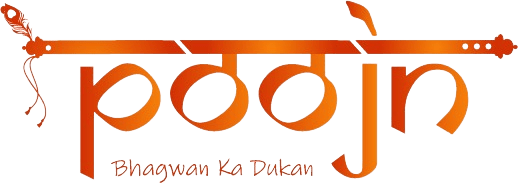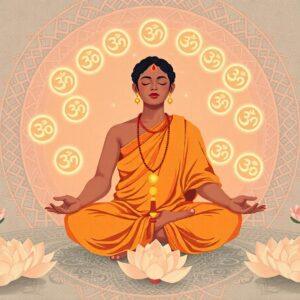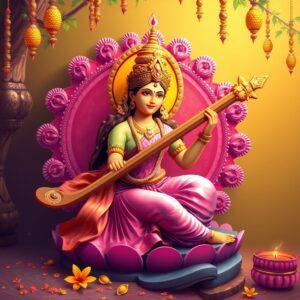Hinduism, one of the world’s oldest religions, is rich with symbolism. These symbols aren’t merely decorative; they hold profound spiritual, historical, and cultural meaning. Understanding them offers a glimpse into the Hindu way of life, philosophy, and rituals.
Key Hindu Symbols and Their Meanings
The Om (Aum) Symbol
Considered the most sacred mantra in Hinduism, Om comprises three phonetic components: A-U-M, representing creation, preservation, and dissolution. Used in meditation and chanting, Om connects practitioners with the divine. Found in scriptures like the Vedas and Upanishads, it symbolizes the ultimate reality, Brahman. Its unique visual form, with curves and a dot, further enhances its symbolic depth. Om is integral to daily prayers and rituals, often marking the beginning and end of ceremonies.
Swastika
The Swastika is an ancient symbol of auspiciousness and good fortune, derived from the Sanskrit word for ‘well-being.’ While there are left-facing (Sauwastika) and right-facing versions, each with unique significance, the Swastika’s presence in temples, homes, and festivals like Diwali underscores its importance. Despite its misappropriation in the 20th century, it remains sacred in Hinduism, invoking blessings and protection. Its continued use in traditional settings highlights its enduring spiritual value.
Lotus Flower
The lotus flower embodies purity, beauty, and spiritual awakening. Its ability to bloom unsullied from muddy waters makes it a potent symbol of detachment and enlightenment. Associated with deities like Lakshmi and Saraswati, the lotus appears frequently in Hindu art and architecture. In rituals, it signifies spiritual growth and divine beauty, reflecting the journey towards enlightenment.
Trishula (Trident)
Lord Shiva’s Trishula represents the powerful trifecta of creation, preservation, and destruction. It also symbolizes the three gunas (sattva, rajas, tamas) and the aspects of time (past, present, future). A prominent feature in Shiva’s iconography, the Trishula signifies overcoming obstacles and negative energies. Its use in religious rituals underscores its power to transform and protect.
Bindi and Tilak
Bindis and Tilaks are forehead markings with deep cultural and religious significance. Worn by both men and women, different types convey various meanings. They are believed to activate the Ajna Chakra (third eye) and play a role in daily rituals and special occasions like weddings. Made from traditional materials like sandalwood paste, kumkum, and ash, they enhance spiritual focus and symbolize devotion.
Kalash (Sacred Pot)
The Kalash, a sacred pot, is essential in Hindu rituals and ceremonies. Symbolizing abundance, fertility, and creation, it often contains mango leaves, coconut, and water to invoke deities, especially during rituals like Purna Kumbha. Traditionally made of copper or brass, the Kalash is an auspicious symbol in Hindu households, representing prosperity and divine blessings.
Yantra
Yantras are geometric diagrams used in meditation and worship. Representing mantras and divine energies, different Yantras serve specific purposes, such as the Sri Yantra for prosperity. Placed in homes and temples for protection, Yantras are created using traditional methods. They enhance spiritual focus during meditation and serve as a visual representation of complex spiritual concepts.
Poojn.in: Your Gateway to Hindu Ritual Items
Looking to connect with these powerful symbols? Poojn.in, India’s leading online store for cultural goods and services, offers a wide selection of authentic items to enrich your spiritual practice. Explore our collection:
- Deity Idols: Find beautifully crafted idols of Lord Vishnu, Krishna, Shiva, Maa Durga, and more, each meticulously designed with traditional symbolism and religious significance. We offer a variety of materials and sizes to suit your needs. Our Laddu Gopal idol is a particularly beloved choice for devotees.
- Sacred Symbols: Discover Om, Swastika, Trishul, and other sacred symbols in various materials, perfect for your home altar or personal meditation space. Our Bel malas are ideal for chanting and connecting with Lord Shiva. We also offer a selection of Tulsi malas, revered for their spiritual properties.
- Yantras and Mandalas: Enhance your spiritual practices with our selection of Yantras and Mandalas, designed to promote focus and connect you with divine energies. Our Shiva Lingams are perfect for establishing a sacred space in your home. Consider our marble dust Adiyogi statue for a powerful representation of the first yogi.
- Puja Sets: Simplify your rituals with our complete puja sets, containing all the essential items and symbols for traditional worship. From incense sticks to diyas, we provide everything you need for a meaningful ceremony. Our Kushal Mangal sandalwood incense sticks create a serene atmosphere for your prayers.
Poojn.in offers expert guidance on selecting appropriate symbols and deity idols based on your spiritual needs. Our customer service team is knowledgeable in Hindu traditions and can assist you in choosing the right sacred items. We deliver across India, bringing authentic spiritual products to your doorstep.
Conclusion
Hindu symbols are more than just images; they are gateways to deeper understanding and connection with the divine. By appreciating their significance, we gain insight into the rich tapestry of Hindu traditions. Poojn.in makes it easier than ever to incorporate these symbols into our lives, fostering a sense of spiritual fulfillment and cultural continuity.
FAQs on Hindu Symbols
What is the most recognizable Hindu symbol? The Om symbol is widely recognized and represents the sound of the universe.
What is the meaning of Om in Hinduism? Om signifies the essence of ultimate reality, consciousness, or Atman.
Why are Hindu symbols important? They convey deep spiritual meanings, represent deities, and are integral to rituals and worship.
What does the Swastika symbolize in Hinduism? It represents good fortune, prosperity, and well-being, symbolizing the sun and its positive energy.
What is the meaning of the Lotus flower in Hinduism? The Lotus symbolizes purity, beauty, and spiritual awakening, representing detachment and enlightenment.
How is the Trishul used in Hindu rituals? Associated with Lord Shiva, the Trishul symbolizes the power to destroy evil and ignorance, invoked for blessings and protection.
What does the Tilaka on the forehead represent? The Tilaka signifies the third eye, spiritual insight, and enlightenment, often applied during religious ceremonies.
Are there specific symbols for Hindu gods and goddesses? Yes, each deity has specific symbols. For instance, Lord Vishnu is associated with the conch and discus, while Lord Shiva is represented by the crescent moon and snake.


